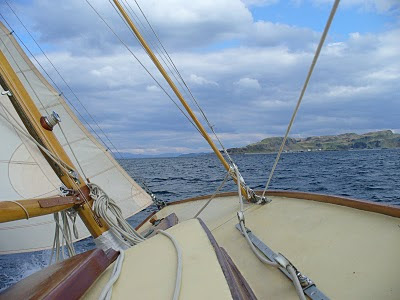The Royal Highland Yacht Club is both one of the oldest and the one of the most modern in the World. The oldest because it dates from 1881, the most modern because it is now well on the way to being a cyber-club, which should ensure a thriving membership.
I have a nice memory from years ago of an oldish well-dressed couple from one of the South coast "Royal" clubs, on the front at Oban asking for directions to our clubhouse, to exercise their rights of reciprocity. They were about fifty years too late. Members of the Club are scattered all over Scotland, with many further afield, so it makes perfect sense not to have a fixed base. Instead we meet at various musters and other events, in and outwith the sailing season, the Summer ones being in well-kent anchoring spots. This gives a perfect opportunity to make a short trip, knowing there will be a convivial event at the end.
The Opening Muster this year on a May weekend was in Loch Spelve, where we enjoyed a mussel feast courtesy of the farm there.
Peter and I set off in Stroma on the Friday, to make a longer weekend. To get more of a sail we went South round the Isle of Luing and carried the tide up past Scarba, the Grey Dogs to the Pladda Light.
 |
| Fladda ahead, Mull beyond (image Peter) |
 |
| Easdale on starboard bow (image Peter) |
 |
| North of the Isles of the Sea, (image Peter) |
 |
| Safe in the pool of the otter (image Peter) |
A great bonus this year was meeting up with our friends Hal and Iain and their pals on the Molly Ban. They anchored outside the lagoon, as at nineteen metres the Molly Ban would have blocked the entrance.
 |
| Molly Ban (image courtesy of riverclydephotgraphy.org) |
 |
| Peigi gets rigged to go for coffee (image PS) |
At about midday we set off for the sail to Loch Spelve, a fast reach in a strong Northerly wind, the sun dancing on a sparkling blue sea, a panorama of little islands to the South, far beyond the normal range of vision.
The Islanders are fantastic on this sort of beam reach, light on the helm while approaching maximum hull speed of about 7 knots. And this stretch of water, framed by the hills of Mull, Kerrera and the upper Firth of Lorn and the Isles of the Sea is small boat heaven.
The entrance to Loch Spelve is long and winding, past the rows of buoys for the mussel ropes, which severely restrict one's sea-room (but of course enable our nice hosts to exist). We were safely anchored by mid afternoon and had a great feast later.
I lost count of the number of tacks getting out on the Sunday, but here are some shots of us leaving, courtesy of Chardonnay.
 |
| images by Diana |
Once clear we had a good run down to the Cuan Sound. Our arrival was timed about right, as we were just at the start of the South-going stream, which is about two hours before High Water. In other words the water level is still rising when it is going South, something to remember if one ever gets stuck.
The Sound is a useful passage to Loch Melfort and is perfectly safe. In particular I don't believe it would be possible to get stuck on the Cleit Rock even if you tried, such is the water pressure around it. The only time we experienced any problem was on a calm day a few years ago when we were buzzed by a powerful RIB, whose bow wave turned Stroma round and we lost steerage way. We had to proceed sternwards for a while, until we could get out of the strongest of the tidal stream and gybe ourselves round in a little bay.
This year we had no problems and were safely moored at the head of the loch in time for tea.




Ewan. How do I join The Royal Highland Yacht Club? Probably too posh for the likes of I, but sounds like a good one. If I'm not up to the mark then Sally II undoubtedly is, being the second of what became the Vertue class. Longer pedigree than mine by miles. It might tempt me to venture forth from Loch Broom next season...
ReplyDeleteAdrian
ReplyDeleteThe modern RHYC is actually a very nice and unstuffy club, not at all like it was in its Victorian period. I'll be happy to propose you and we'll need to find another member who knows you.
Ewan
Thanks Ewan. I can't help feeling that if there's someone in the club who knows me then, to paraphrase Groucho Marx, it can't be that posh! I like the idea of a club with no house though. Your Nutshell looks the part. I agree that, if you are after a tender, then this is the one.
ReplyDelete